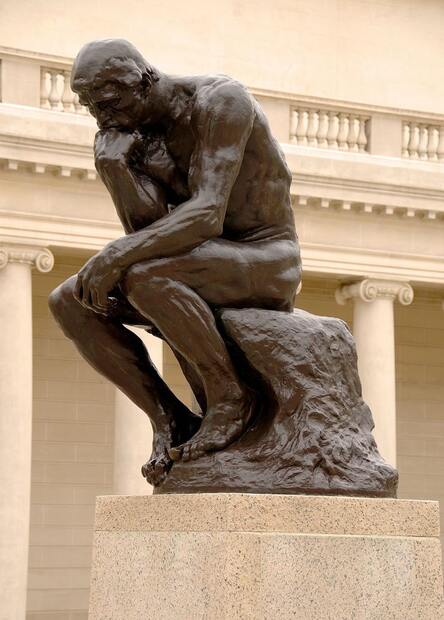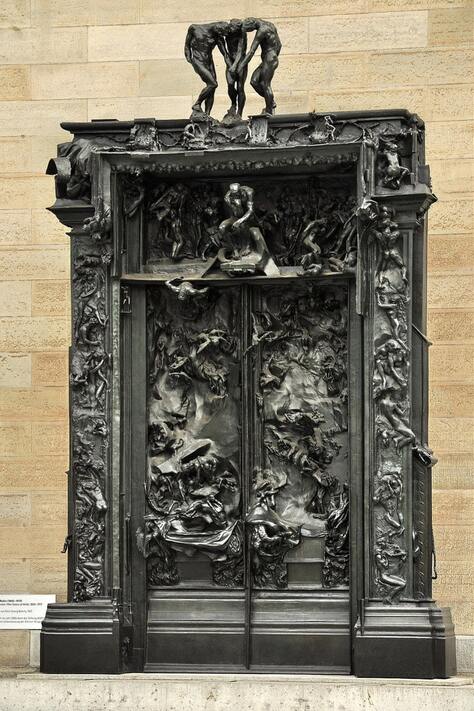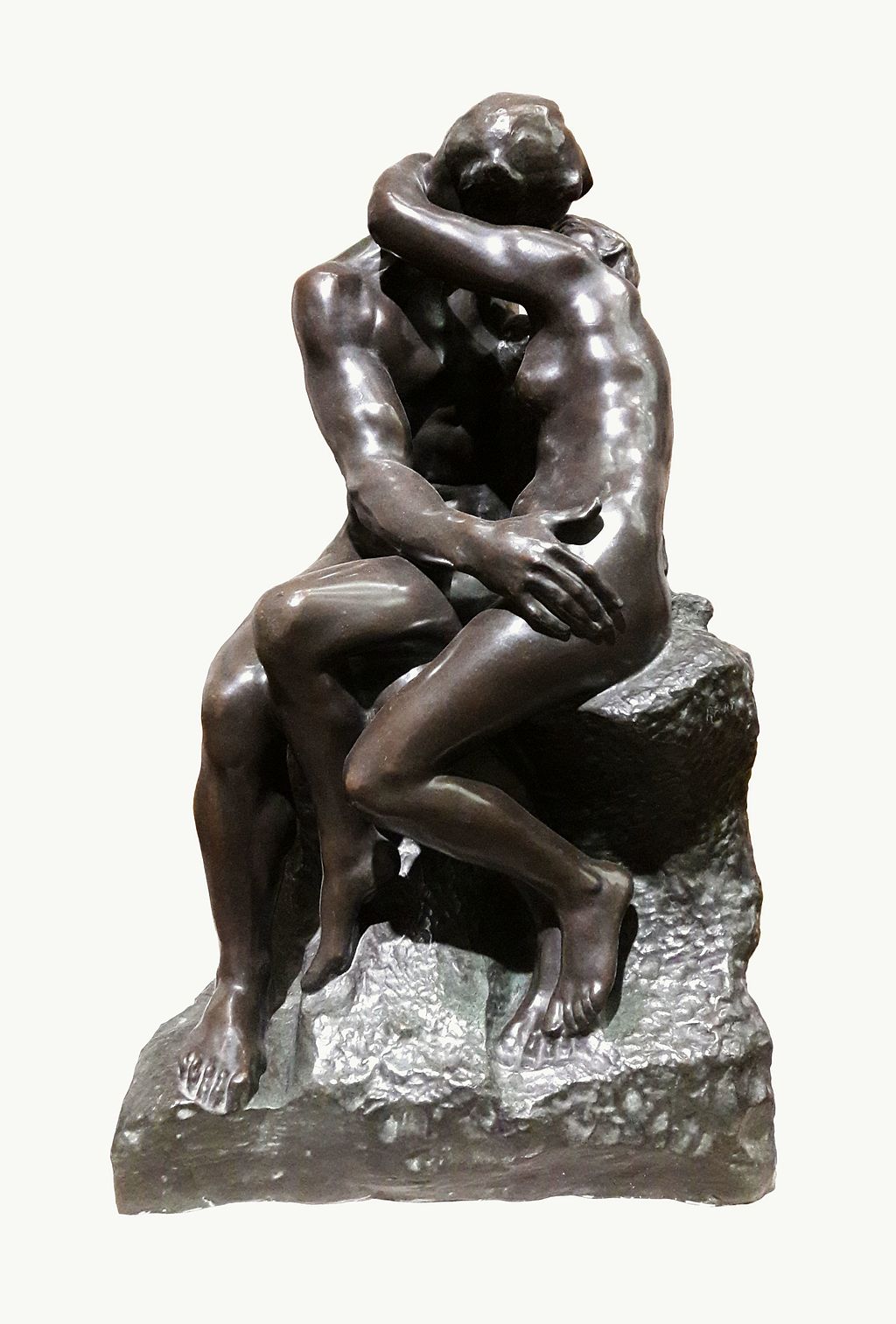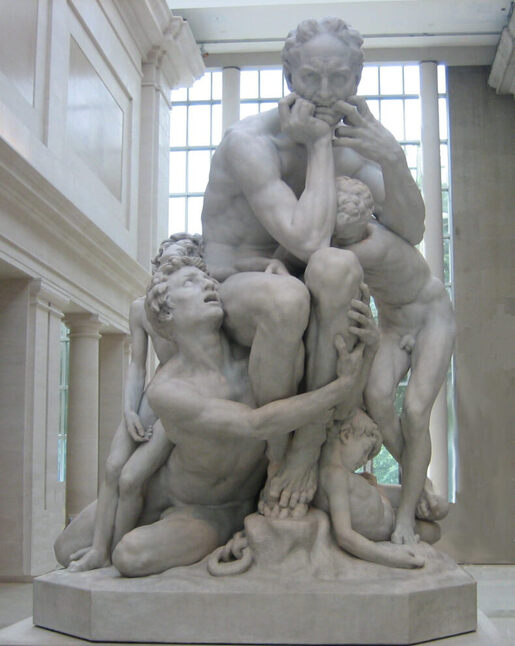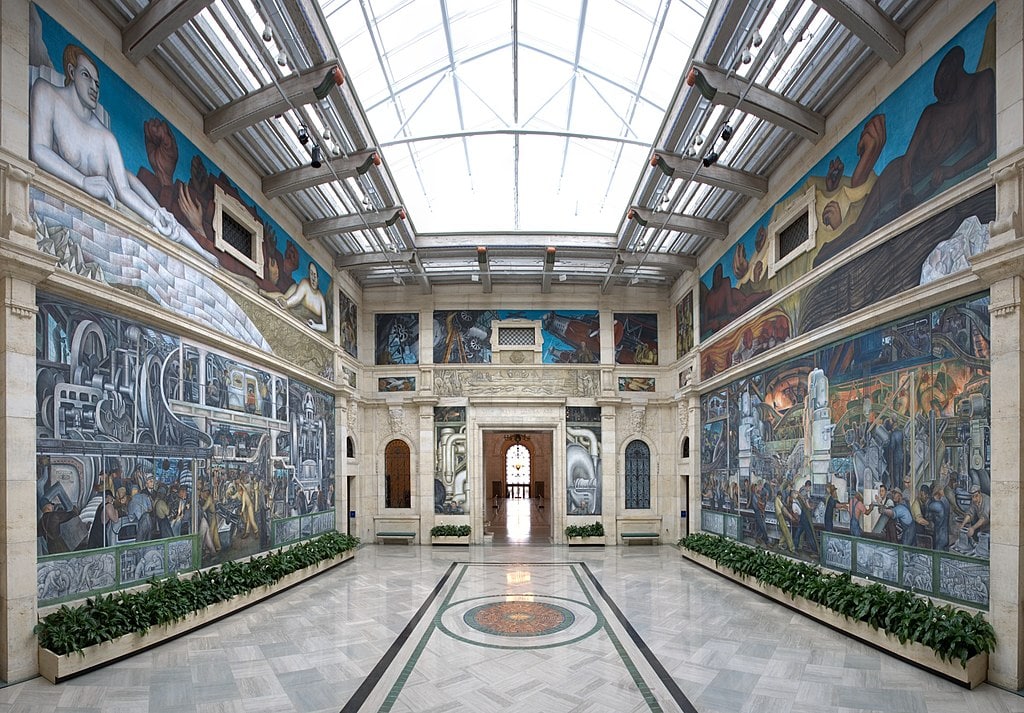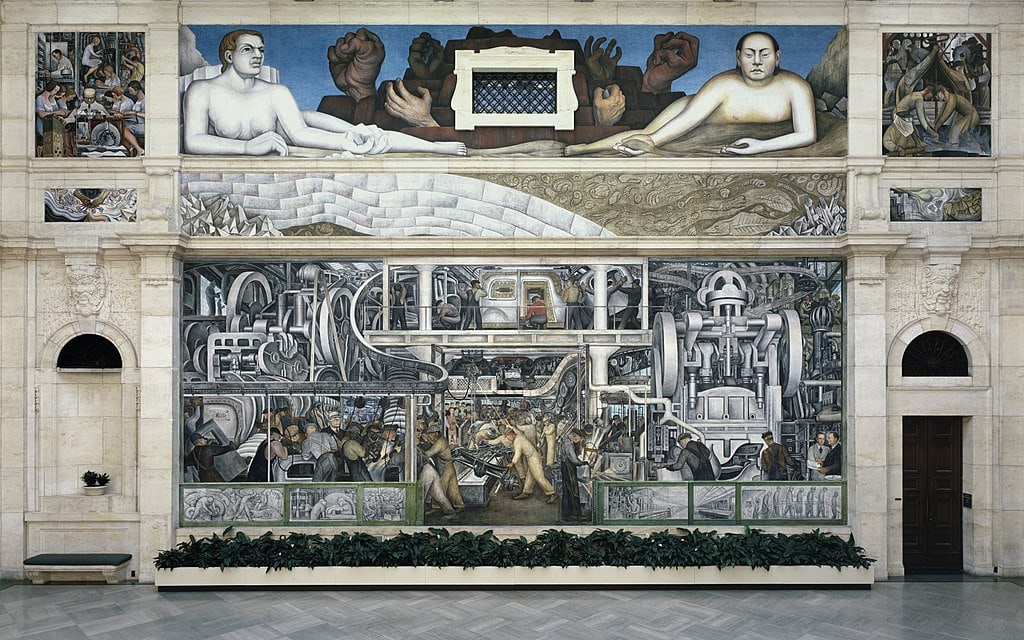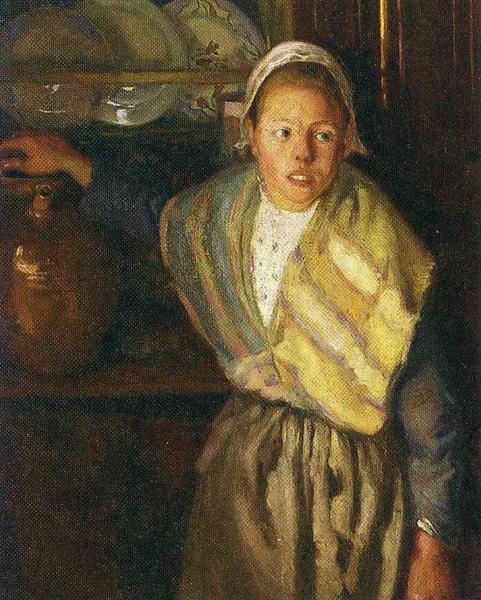|
Where?
When? Rodin created the original sculpture in 1881. He created the first monumental-size sculpture in 1903 and after this many casts of the sculpture have been created, even after his death in 1917. What do you see? A sculpture of a muscular, naked man sitting on a rock. The man is in deep thought and uses his whole body to think. His head is bent forward and leans on his right hand. His wrinkled face, knitted eyebrows, swollen nostrils, compressed lips, and absent-minded gaze reinforce the idea that the man is deep in his thoughts and is completely unaware of the world around him. The man is struggling with his thoughts with every part of his body. Almost no part of his body is relaxed. Most muscles are tense, which is clear by looking at the clenched fist, the arched back, the legs below his body, and the squeezed toes. The statue is over six feet tall making the figure larger than life. It was the intention of Rodin to put the independent sculpture on top of a pedestal such that it would make a colossal impression on the viewers. Backstory: In 1880, Rodin received a large commission from the Directorate of Fine Arts in France to create the entrance doors for a new museum that was to be built (but never opened in the end). He was given the freedom to choose his own theme and decided on creating a scene from Dante’s book Inferno. Rodin was supposed to finish the project in five years but continued to work on the project for 37 years until his death in 1917. The doors – named The Gates of Hell – would eventually include a total of 180 different figures, and they would form the basis for many of Rodin’s most famous statues. Rodin originally created all figures in plaster, and the doors were then to be cast in bronze. The central and the most important part Rodin created for these doors was the statue of The Thinker (Le Penseur in French) who sits right above the two doors with all the characters from the Inferno behind him. The statue was about 27 inches (70 cm) high.
Multiple versions: The statue of The Thinker can be found all around the world. Rodin created the first version of this statue in plaster in 1881. In 1903, he completed the first monumental-size version of this statue. He considered it to be a remarkable piece and wrote to the client of his first bronze casting that he would ensure that only a few copies of the statue would ever be made. However, he did not keep his word.
During Rodin’s life, already more than 20 versions of The Thinker were produced. And after his death, the right for reproduction was turned over to the Republic of France. Nowadays, more than 70 bronze and plaster versions exist and are on display in Asia, Australia, Europe, North America, and South America. Interpretation: There are various interpretations of what and who The Thinker represents. When initially creating this statue as part of The Gates of Hell, Rodin meant the figure to represent Dante pondering about the fate of the damned people entering through the Gates of Hell. This interpretation is based on Dante’s book Inferno, the first part of his trilogy known as The Divine Comedy. When Rodin started to create independent versions, he started to consider different interpretations. Overall, he considered the statue to represent the struggle of the human mind. But he also started to see hope in it. The thoughts slowly become clear, and the man turns from a thinker, into a dreamer, and finally into a creator. Over time, other interpretations have also been given. Some consider the statue to represent Rodin himself. Others interpret the figure as Adam contemplating the sin he committed in Paradise. Who is Rodin? François Auguste René Rodin was born in 1840 in Paris, where he died 77 years later in 1917. He was rejected three times by the leading art school in Paris, the École des Beaux-Arts. It forced him to educate himself differently and this has contributed to his unique style. He was inspired by some of the great Renaissance sculptors like Donatello and Michelangelo. Most of Rodin's famous sculptures were originally intended for his commission of The Gates of Hell. Over time, he realized that he could turn many elements of The Gates of Hell into separate statues and some of these statues have achieved world fame. Among them are The Three Shades and The Kiss. Many of Rodin’s statues have been cast multiple times in bronze which means that his statues have spread across the world.
Why a bronze statue? Bronze is a combination of different metals. It consists primarily of copper (typically 85-90%) and tin (typically 10-15%), but can also contain minor quantities of other metals or nonmetals. It is an attractive material for sculptors for the following reasons.
Fun fact: While The Thinker is one of the most famous statues in the world, Rodin initially named this statue “the poet.” Later it was renamed based on suggestions by foundry workers that the sculpture was quite similar to a sculpture by Michelangelo on Lorenzo de’ Medici, Duke of Urbino. This sculpture was more popularly known as “Il Penseroso” (The Thinker), and this name was also given to Rodin’s statue. The Thinker also shows some resemblance to Ugolino and His Sons which was created by Jean-Baptiste Carpeaux in the 1860s.
1 Comment
Where: Rivera Court C200, Level 2 (formerly Garden Court) of the Detroit Institute of Art.
When: 1932-1933. Commissioned by: Edsel Ford and Wilhelm Valentiner What do you see? On four walls of the court, Diego Rivera painted 27 panels with highly allegorical scenes pertaining to the history of Detroit and the development of its industry. The dominant theme is the auto industry and its place in the city’s life. Many panels depict the lives and work of the workers of the Ford Motor Company. The murals are full of symbolism and address questions like how to achieve the balance between the use and abuse of both nature and people. And the symbolism of the murals begins with their layout.
East Wall: This wall faces the sunrise, consistent with the new dawn, new beginning, new life in which man and nature are in harmony. The scene has a child in the center, placed in the bulb of a plant and shielded by roots, fruits and vegetables native to Michigan. Both ends of the main scene lead to the upper panels featuring large nude figures holding grain and other goods of the earth symbolizing both the giving nature and appreciation of humans.
North Wall: This wall relates to darkness or the inner side of reality. In this case, the reality is human work represented by the auto workers building a car. Above the many figures engaged in the variety of tasks are the orange and red of the giant furnace which is blasting fire. The conveyer belts and assembly lanes are attended by the muscled-up men around the two milling machines, which, in turn, direct the viewer’s eye deep into the composition and towards the glazing furnace; here steel is melting for the molds of parts—the soon-to-be automobiles. The art here is more direct and representational.
South Wall: This wall delves back into symbolism. Central to the understanding of the scene is the stamping press, located on the right side of the wall. If one considers Rivera’s Mexican background and the allegorical character of many of his murals, the resemblance of the shape of the press to that of Coatlicue -- the Aztec earth-mother goddess, who lived off human hearts -- becomes apparent. The deity oversaw both creating and annihilating life.
In the context of the Detroit Industry Murals, Coatlicue ruled and gave meaning to the sacrificial character of the factory work. The finished car in the upper mid-section gives the illusion of completeness, but there is more… West Wall: This wall completes the cycle; it also contrasts with the serene character of the southern wall. Here, the bombers and planes warn of the dual nature of the technological advancements. The west wall faces sunsets and symbolizes finality. Smaller panels: In addition to the scenes on the main planes of the walls, there are numerous smaller panels. For example, the upper north and south panels show large figures in different colors, recognizing the value of diversity in the workforce (red for iron ore, white for limestone, yellow for sand and black for coal and diamond). Each color corresponds with the material used for auto manufacturing; each has a value of its own and is indispensable like the representatives of the many races, who are all in the task together. The materials symbolize the strengths of each race. Another smaller panel on the upper right side of the north wall features a baby being vaccinated, held by the parents accompanied by three men. A horse and a cow help decipher the symbolic reference to the nativity scene. Background: Some allegories in the murals were perceived as controversial. For instance, the nudes present on panels were thought to be pornographic, the nativity scene was read as blasphemous, and the idea that a multiracial workforce was a positive thing was not shared by everyone in the United States. Additionally, Rivera’s political views were visible in most of his works. As a staunch communist, he was one of the founders of the Mexican Revolutionary Union of Technical Workers, Painters, and Sculptors, in 1922. Another mural by him, Man at the Crossroads (1934), in Rockefeller Center in New York City, was removed in 1934 after it was discovered to have featured Vladimir Lenin and the Soviet May Day Parade. The Detroit Industry Murals have survived mainly thanks to the support of Edsel Ford, the son of Henry Ford and president of the Ford Motor Company. But the decision only followed the uproar of protests from the Catholic Church, students, workers, attacks by the press and the Detroit City Council’s debate on their fate; thousands of signatures had been signed under the petition to destroy them. Who is Rivera? Diego Rivera was born on December 8, 1886 in Guanajuato, Mexico and died on November 24, 1957 in Mexico City. He showed strong artistic talent early in life. He attended the San Carlos Academy of Fine Arts when he was approximately 12 years old, finishing it in 1905. The government sponsored his intense, long travel-study through Europe where he met several prominent artists, including Modigliani who painted a portrait of him. He showed six paintings in the 1910 exhibit sponsored by The Society of Independent Artists in Paris. Rivera's style evolved quickly; after initial impressionistic marks present in the Breton Girl and House Over the Bridge, Rivera absorbed Cubism fully by 1913. His trip to Italy in 1920 resulted in fascination with the Renaissance fresco. When he returned to Mexico, the fascination translated into mural painting, for which he is now arguably best known. Diego Rivera’s political life was colorful and an integral part of his art. The Mexican Revolution and the Revolution of 1917 sealed forever his staunch devotion to communism and belief in the revolutionary mission of arts. But his many commissions in the United States were among reasons, for which he was also called by many a charlatan and a “millionaire artist for the establishment.” Rivera was expelled from the party in 1929, for disloyalty to the Comintern, but, in reality, for the catch-all sin of Trotskyism. Leo Trotsky lived with Rivera for some seven months in the 1930s while in exile. He is featured in Arsenal along with Rivera’s third wife, Frida Kahlo.
Fun fact: The Detroit Industry Murals were finished in a relatively short period of time; after about a month of preliminary drawings, Rivera started to work on them in July 1932 and finished in March 1933.
One of the most intriguing friendships Rivera developed during that time was with Edsel Ford, son of the Ford Motor Company founder and president. He was anti-communist, anti-union and pro-business magnate of capitalism, yet he is the one who paid for a substantial part of the Detroit Industry Murals. |
Categories
All
|
- Home
- Blog
-
Museums
- Alte Pinakothek
- Art Institute of Chicago
- Baltimore Museum of Art
- Barber Institute of Fine Arts
- Bargello
- Barnes Foundation
- British Museum
- Church of Sant’Anastasia
- Cleveland Museum of Art
- Courtauld Institute of Art
- Detroit Institute of Arts
- Frans Hals Museum
- Galleria Borghese
- Gallerie dell'Accademia
- Getty Museum
- Guggenheim
- Hermitage Museum
- Kunsthistorisches Museum
- Kunstmuseum Basel
- Legion of Honor Museum
- Louvre
- Mauritshuis
- Metropolitan Museum of Art
- Musee d’Orsay
- Museum of Fine Arts in Boston
- Museum of Modern Art
- National Gallery in London
- National Gallery of Art
- National Museum in Poznań
- Norton Simon Museum
- Ny Carlsberg Glyptotek
- Palace of Versailles
- Palazzo Pitti
- Palazzo Vecchio
- Petit Palais
- Philadelphia Museum of Art
- Prado
- Pushkin Museum
- Ravenna Art Museum
- Rijksmuseum
- San Diego Museum of Art
- Santa Maria delle Grazie
- St. Peter's Basilica
- Städel Museum
- Statens Museum for Kunst
- Tate Britain
- Tate Modern
- Timken Museum of Art
- Uffizi
- Vatican Museums
- Wallace Collection
-
Artists
- Altdorfer
- Anguissola
- Berlin Painter
- Bosch
- Botticelli
- Boucher
- Bronzino
- Bruegel the Elder
- Brunelleschi
- Cabanel
- Caillebotte
- Canova
- Caravaggio
- Carpeaux
- Cezanne
- Cimabue
- David
- Degas
- Delacroix
- De Maria
- Donatello
- El Greco
- Fontana
- Fra Angelico
- Fragonard
- Gauguin
- Gentileschi
- Gericault
- Gonzalez-Torres
- Goya
- Hals
- Hogarth
- Hokusai
- Ingres
- Leonardo da Vinci
- Lippi, Filippo
- Longhi, Barbara
- Lorrain
- Makovsky
- Manet
- Massys
- Matisse
- Merian
- Michelangelo
- Mochi
- Modigliani
- Monet
- Panini
- Parmigianino
- Perugino
- Picasso
- Pisanello
- Raphael
- Rembrandt
- Renoir
- Reynolds
- Rivera
- Rodin
- Rubens
- Scultori
- Seurat
- Steen
- Tintoretto
- Titian
- Toulouse-Lautrec
- Turner
- Uccello
- Van der Weyden
- Van Dyck
- Van Eyck
- Van Gogh
- Van Hemessen
- Vasari
- Velazquez
- Vermeer
- Veronese
- Vigée Le Brun
-
Locations
- Books
- About Us

